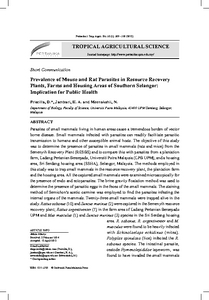Citation
Das, Priscilla and Ali, Jambari and N., Meenakshii
(2015)
Prevalence of mouse and rat parasites in resource recovery plants, farms and housing areas of Southern Selangor: implication for public health.
Pertanika Journal of Tropical Agricultural Science, 38 (3).
pp. 309-320.
ISSN 1511-3701; ESSN: 2231-8542
Abstract
Parasites of small mammals living in human areas cause a tremendous burden of vector borne disease. Small mammals infected with parasites can readily facilitate parasitic transmission to humans and other susceptible animal hosts. The objective of this study was to determine the presence of parasites in small mammals (rats and mice) from the Semenyih Recovery Plant (RESBS) and to compare this with parasites from a plantation farm, Ladang Pertanian Bersepadu, Universiti Putra Malaysia (LPB UPM), and a housing area, Sri Serdang housing area (SSHA), Selangor, Malaysia. The methods employed in this study was to trap small mammals in the resource recovery plant, the plantation farm and the housing area. All the captured small mammals were examined microscopically for the presence of endo and ectoparasites. The brine gravity floatation method was used to determine the presence of parasitic eggs in the feces of the small mammals. The staining method of Semichon’s acetic carmine was employed to find the parasites infesting the internal organs of the mammals. Twenty-three small mammals were trapped alive in the study. Rattus sabanus (10) and Suncus murinus (2) were captured in the Semenyih resource recovery plant; Rattus argentiventer (7) in the farm area of Ladang Pertanian Bersepadu UPM and Mus musculus (1) and Suncus murinus (3) species in the Sri Serdang housing area. R. sabanus, R. argentiventer and M. musculus were found to be heavily infected with Echinolaelaps echidinus (mites). Polyplax spinulosa (lice) infected the R. sabanus species. The intestinal parasite, cestode Hymenolepididae tapeworm, was found to have invaded the small mammals from Semenyih, the resource recovery plant and the farm area of Ladang Pertanian Bersepadu UPM. The nematodes were also found in the small mammals from RESBS. The small mammals captured from RESBS were found to be heavily infected with both external and internal parasites including E. echidinus, P. spinulosa, cestode tapeworms and nematodes compared to the farm and housing areas. Therefore, the existence of small mammals carrying parasites found mainly in waste disposal areas needs to be addressed to prevent serious disease that can cause harm to human health.
Download File
![[img]](http://psasir.upm.edu.my/41831/1.hassmallThumbnailVersion/Prevalence%20of%20mouse%20and%20rat%20parasites%20in%20resource%20recovery%20plants%2C%20farms%20and%20housing.pdf)  Preview |
|
PDF
Prevalence of mouse and rat parasites in resource recovery plants, farms and housing.pdf
Download (736kB)
| Preview
|
|
Additional Metadata
Actions (login required)
 |
View Item |

